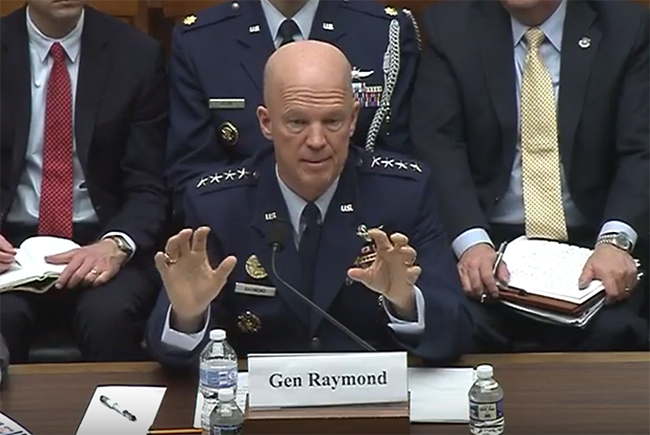
Air Force Space Command chief Gen. Jay Ramond testifies before the House Armed Services Committee's Strategic Forces subcommittee on April 3, 2019, in Washington, D.C. YouTube screenshot.
House Armed Services Committee members on Wednesday questioned how the various services’ space assets will fit together and whether creating new space organizations will render existing agencies useless, including the Air Force’s Space and Missile Systems Center.
At a hearing on military space priorities, Rep. Mike Rogers (R-Ala.) asked Air Force Space Command chief Gen. Jay Raymond if the new Space Development Agency would step on the toes of SMC, which oversees development, procurement, fielding, and sustainment of space assets.
“In my view, I don’t know why we would need an SMC once we have a full-blown Space Development Agency,” said Rogers, who led the push for a new Space Corps two years ago.
Raymond responded that like the Air Force’s recently created Space Rapid Capabilities Office, an SDA would help field new systems faster.
“I look forward to working with [Pentagon acquisition chief Michael] Griffin as we go forward to make sure that these are synchronized activities and not competing,” he said.
During a Senate Armed Services strategic forces subcommittee hearing the same day, Missile Defense Agency Director USAF Lt. Gen. Samuel Greaves made the case that the SDA is the best candidate to build a space sensor layer that can help with hypersonic missile defense. That low-earth orbit layer is the SDA’s first project.
Under Secretary of Defense for Policy John Rood also told senators the SDA, which will leverage similar efforts as the Defense Advanced Research Projects Agency, has started its work with a small staff and its director, former DARPA official Fred Kennedy.
At the HASC strategic forces subcommittee hearing, Kenneth Rapuano, the Defense Department’s assistant secretary of defense for homeland defense and global security, noted SDA is not intended to replace or displace existing institutions. As space needs grow, he said, the Pentagon wants to seek out new experts to tackle the issues and ensure they work together.
When asked what will happen to service-specific space organizations, Rapuano said those that are unique to a service and are needed to execute their missions will stay put. The Space Force would oversee other missions like global GPS and communications that pertain to the entire military.
Rogers also told Raymond there are glaring “cross-jurisdictional” issues with the Defense Department’s Space Force proposal that Congress will have to clean up. Though Rogers did not elaborate on what those are, Rep. Joe Courtney (D-Conn.) mentioned at a hearing on Tuesday that he’s skeptical of the leeway the plan allows DOD to move money around.
“There’s some pretty extraordinary transfer authorities which the administration is proposing, [including] … seven-year blanket funding that would allow DOD to move funding from anywhere in the department to the Space Force as long as it’s somehow connected,” Courtney said. “Given what’s going on right now in terms of the heartburn surrounding the transfer authority for border projects, why can’t we just do a one-year transfer and then [fund the rest] through normal budgeting?”
Air Force Secretary Heather Wilson told Courtney the military needs to be able to transfer money as needed for more than a year without offering specifics. Courtney worries being able to do so would dramatically change the cost of standing up a Space Force from the expected $2 billion in five years. Wilson answered the service would work with Congress on the details of the plan.
“There is a proposal which we support,” she told lawmakers. “We also recognize that this is a conversation and that legislation is required by this committee, by the House and by the Senate, and we are open to discussing those things with all of you.”